+ Open data
Open data
- Basic information
Basic information
| Entry | Database: PDB / ID: 4xt3 | |||||||||
|---|---|---|---|---|---|---|---|---|---|---|
| Title | Structure of a viral GPCR bound to human chemokine CX3CL1 | |||||||||
 Components Components |
| |||||||||
 Keywords Keywords | VIRAL PROTEIN/SIGNALLING PROTEIN / GPCR / chemokine / membrane protein / complex / VIRAL PROTEIN-CYTOKINE complex / VIRAL PROTEIN-SIGNALLING PROTEIN complex | |||||||||
| Function / homology |  Function and homology information Function and homology informationCXCR1 chemokine receptor binding / positive regulation of calcium-independent cell-cell adhesion / negative regulation of interleukin-1 alpha production / leukocyte adhesive activation / CX3C chemokine receptor binding / negative regulation of glutamate receptor signaling pathway / autocrine signaling / lymphocyte chemotaxis / synapse pruning / positive regulation of microglial cell migration ...CXCR1 chemokine receptor binding / positive regulation of calcium-independent cell-cell adhesion / negative regulation of interleukin-1 alpha production / leukocyte adhesive activation / CX3C chemokine receptor binding / negative regulation of glutamate receptor signaling pathway / autocrine signaling / lymphocyte chemotaxis / synapse pruning / positive regulation of microglial cell migration / regulation of lipopolysaccharide-mediated signaling pathway / negative regulation of microglial cell activation / negative regulation of neuron migration / negative regulation of hippocampal neuron apoptotic process / positive regulation of transforming growth factor beta1 production / CCR chemokine receptor binding / microglial cell proliferation / positive regulation of actin filament bundle assembly / leukocyte migration involved in inflammatory response / integrin activation / C-C chemokine receptor activity / chemokine-mediated signaling pathway / eosinophil chemotaxis / C-C chemokine binding / leukocyte chemotaxis / angiogenesis involved in wound healing / chemokine activity / Chemokine receptors bind chemokines / negative regulation of interleukin-1 beta production / positive regulation of cell-matrix adhesion / neuron remodeling / symbiont-mediated transformation of host cell / positive regulation of neuroblast proliferation / positive chemotaxis / chemoattractant activity / macrophage chemotaxis / negative regulation of interleukin-6 production / negative regulation of apoptotic signaling pathway / negative regulation of tumor necrosis factor production / negative regulation of cell-substrate adhesion / regulation of neurogenesis / negative regulation of extrinsic apoptotic signaling pathway in absence of ligand / extrinsic apoptotic signaling pathway in absence of ligand / neutrophil chemotaxis / positive regulation of smooth muscle cell proliferation / negative regulation of cell migration / positive regulation of release of sequestered calcium ion into cytosol / response to ischemia / cell chemotaxis / cell projection / calcium-mediated signaling / microglial cell activation / defense response / cell-cell adhesion / positive regulation of neuron projection development / neuron cellular homeostasis / regulation of synaptic plasticity / integrin binding / cytokine-mediated signaling pathway / chemotaxis / positive regulation of angiogenesis / positive regulation of inflammatory response / antimicrobial humoral immune response mediated by antimicrobial peptide / cell-cell signaling / positive regulation of cytosolic calcium ion concentration / G alpha (i) signalling events / positive regulation of ERK1 and ERK2 cascade / positive regulation of canonical NF-kappaB signal transduction / positive regulation of phosphatidylinositol 3-kinase/protein kinase B signal transduction / cell adhesion / positive regulation of MAPK cascade / neuron projection / immune response / positive regulation of cell migration / G protein-coupled receptor signaling pathway / inflammatory response / signaling receptor binding / neuronal cell body / positive regulation of cell population proliferation / negative regulation of apoptotic process / perinuclear region of cytoplasm / host cell plasma membrane / cell surface / positive regulation of transcription by RNA polymerase II / extracellular space / extracellular region / membrane / plasma membrane Similarity search - Function | |||||||||
| Biological species |  Cytomegalovirus Cytomegalovirus Homo sapiens (human) Homo sapiens (human) | |||||||||
| Method |  X-RAY DIFFRACTION / X-RAY DIFFRACTION /  SYNCHROTRON / SYNCHROTRON /  MOLECULAR REPLACEMENT / Resolution: 3.801 Å MOLECULAR REPLACEMENT / Resolution: 3.801 Å | |||||||||
 Authors Authors | Burg, J.S. / Jude, K.M. / Waghray, D. / Garcia, K.C. | |||||||||
 Citation Citation |  Journal: Science / Year: 2015 Journal: Science / Year: 2015Title: Structural biology. Structural basis for chemokine recognition and activation of a viral G protein-coupled receptor. Authors: Burg, J.S. / Ingram, J.R. / Venkatakrishnan, A.J. / Jude, K.M. / Dukkipati, A. / Feinberg, E.N. / Angelini, A. / Waghray, D. / Dror, R.O. / Ploegh, H.L. / Garcia, K.C. | |||||||||
| History |
|
- Structure visualization
Structure visualization
| Structure viewer | Molecule:  Molmil Molmil Jmol/JSmol Jmol/JSmol |
|---|
- Downloads & links
Downloads & links
- Download
Download
| PDBx/mmCIF format |  4xt3.cif.gz 4xt3.cif.gz | 88.7 KB | Display |  PDBx/mmCIF format PDBx/mmCIF format |
|---|---|---|---|---|
| PDB format |  pdb4xt3.ent.gz pdb4xt3.ent.gz | 63 KB | Display |  PDB format PDB format |
| PDBx/mmJSON format |  4xt3.json.gz 4xt3.json.gz | Tree view |  PDBx/mmJSON format PDBx/mmJSON format | |
| Others |  Other downloads Other downloads |
-Validation report
| Arichive directory |  https://data.pdbj.org/pub/pdb/validation_reports/xt/4xt3 https://data.pdbj.org/pub/pdb/validation_reports/xt/4xt3 ftp://data.pdbj.org/pub/pdb/validation_reports/xt/4xt3 ftp://data.pdbj.org/pub/pdb/validation_reports/xt/4xt3 | HTTPS FTP |
|---|
-Related structure data
| Related structure data | 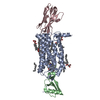 4xt1C  1f2lS  3onaS 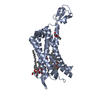 4mbsS C: citing same article ( S: Starting model for refinement |
|---|---|
| Similar structure data |
- Links
Links
- Assembly
Assembly
| Deposited unit | 
| ||||||||
|---|---|---|---|---|---|---|---|---|---|
| 1 |
| ||||||||
| Unit cell |
| ||||||||
| Components on special symmetry positions |
|
- Components
Components
| #1: Protein | Mass: 42041.098 Da / Num. of mol.: 1 Source method: isolated from a genetically manipulated source Source: (gene. exp.)  Cytomegalovirus / Cell line (production host): HEK293s GnTI- / Production host: Cytomegalovirus / Cell line (production host): HEK293s GnTI- / Production host:  Homo sapiens (human) / References: UniProt: P69332 Homo sapiens (human) / References: UniProt: P69332 |
|---|---|
| #2: Protein | Mass: 10013.487 Da / Num. of mol.: 1 / Fragment: UNP residues 25-101 Source method: isolated from a genetically manipulated source Source: (gene. exp.)  Homo sapiens (human) / Gene: CX3CL1, FKN, NTT, SCYD1, A-152E5.2 / Cell line (production host): HEK293s GnTI- / Production host: Homo sapiens (human) / Gene: CX3CL1, FKN, NTT, SCYD1, A-152E5.2 / Cell line (production host): HEK293s GnTI- / Production host:  Homo sapiens (human) / References: UniProt: P78423 Homo sapiens (human) / References: UniProt: P78423 |
| #3: Polysaccharide | 2-acetamido-2-deoxy-beta-D-glucopyranose-(1-4)-2-acetamido-2-deoxy-beta-D-glucopyranose-(1-4)-2- ...2-acetamido-2-deoxy-beta-D-glucopyranose-(1-4)-2-acetamido-2-deoxy-beta-D-glucopyranose-(1-4)-2-acetamido-2-deoxy-beta-D-glucopyranose / triacetyl-beta-chitotriose |
| #4: Chemical | ChemComp-UNL / Mass: 94.971 Da / Num. of mol.: 1 / Source method: obtained synthetically |
| #5: Chemical | ChemComp-PO4 / |
| Has protein modification | Y |
-Experimental details
-Experiment
| Experiment | Method:  X-RAY DIFFRACTION / Number of used crystals: 26 X-RAY DIFFRACTION / Number of used crystals: 26 |
|---|
- Sample preparation
Sample preparation
| Crystal | Density Matthews: 2.62 Å3/Da / Density % sol: 52.99 % |
|---|---|
| Crystal grow | Temperature: 293 K / Method: lipidic cubic phase / pH: 7.4 / Details: PEG 300, HEPES, ammonium phosphate |
-Data collection
| Diffraction | Mean temperature: 100 K |
|---|---|
| Diffraction source | Source:  SYNCHROTRON / Site: SYNCHROTRON / Site:  APS APS  / Beamline: 23-ID-D / Wavelength: 1.033 Å / Beamline: 23-ID-D / Wavelength: 1.033 Å |
| Detector | Type: PILATUS3 6M / Detector: PIXEL / Date: Apr 20, 2014 |
| Radiation | Protocol: SINGLE WAVELENGTH / Monochromatic (M) / Laue (L): M / Scattering type: x-ray |
| Radiation wavelength | Wavelength: 1.033 Å / Relative weight: 1 |
| Reflection | Resolution: 3.8→48.92 Å / Num. obs: 4834 / % possible obs: 85 % / Redundancy: 5.6 % / Rmerge(I) obs: 0.275 / Net I/σ(I): 4.1 |
| Reflection shell | Resolution: 3.8→3.937 Å / Redundancy: 2.9 % / Rmerge(I) obs: 0.555 / Mean I/σ(I) obs: 1.6 / % possible all: 55.5 |
- Processing
Processing
| Software |
| ||||||||||||||||||||||||||||
|---|---|---|---|---|---|---|---|---|---|---|---|---|---|---|---|---|---|---|---|---|---|---|---|---|---|---|---|---|---|
| Refinement | Method to determine structure:  MOLECULAR REPLACEMENT MOLECULAR REPLACEMENTStarting model: 4MBS, 1F2L, 3ONA Resolution: 3.801→48.92 Å / SU ML: 0.66 / Cross valid method: FREE R-VALUE / σ(F): 1.35 / Phase error: 39.58 / Stereochemistry target values: ML
| ||||||||||||||||||||||||||||
| Solvent computation | Shrinkage radii: 0.8 Å / VDW probe radii: 1.1 Å / Solvent model: FLAT BULK SOLVENT MODEL | ||||||||||||||||||||||||||||
| Refinement step | Cycle: LAST / Resolution: 3.801→48.92 Å
| ||||||||||||||||||||||||||||
| Refine LS restraints |
| ||||||||||||||||||||||||||||
| LS refinement shell |
|
 Movie
Movie Controller
Controller



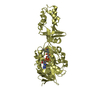
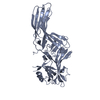
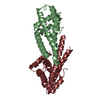
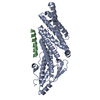
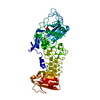
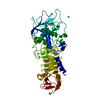
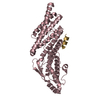

 PDBj
PDBj















